FIAT 600 2007 1.G Owners Manual
Manufacturer: FIAT, Model Year: 2007, Model line: 600, Model: FIAT 600 2007 1.GPages: 146, PDF Size: 2.05 MB
Page 121 of 146
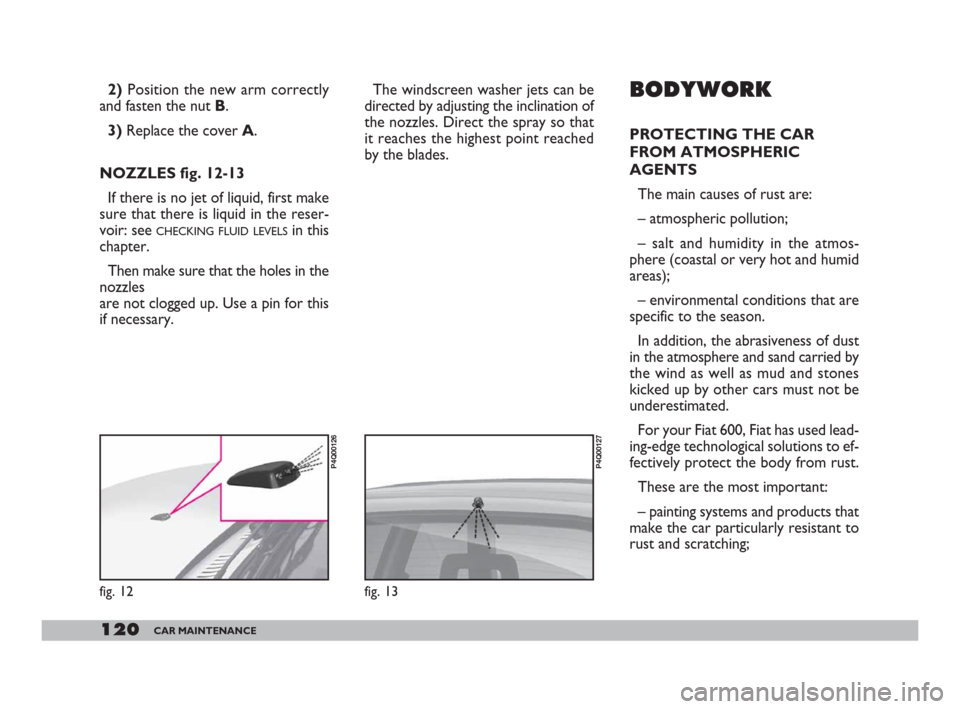
120CAR MAINTENANCE
The windscreen washer jets can be
directed by adjusting the inclination of
the nozzles. Direct the spray so that
it reaches the highest point reached
by the blades. BODYWORK
PROTECTING THE CAR
FROM ATMOSPHERIC
AGENTS
The main causes of rust are:
– atmospheric pollution;
– salt and humidity in the atmos-
phere (coastal or very hot and humid
areas);
– environmental conditions that are
specific to the season.
In addition, the abrasiveness of dust
in the atmosphere and sand carried by
the wind as well as mud and stones
kicked up by other cars must not be
underestimated.
For your Fiat 600, Fiat has used lead-
ing-edge technological solutions to ef-
fectively protect the body from rust.
These are the most important:
– painting systems and products that
make the car particularly resistant to
rust and scratching; 2) Position the new arm correctly
and fasten the nut B.
3) Replace the cover A.
NOZZLES fig. 12-13
If there is no jet of liquid, first make
sure that there is liquid in the reser-
voir: see
CHECKING FLUID LEVELSin this
chapter.
Then make sure that the holes in the
nozzles
are not clogged up. Use a pin for this
if necessary.
fig. 13
P4Q00127
fig. 12
P4Q00126
105-123 Seicento GB 22-11-2007 10:51 Pagina 120
Page 122 of 146
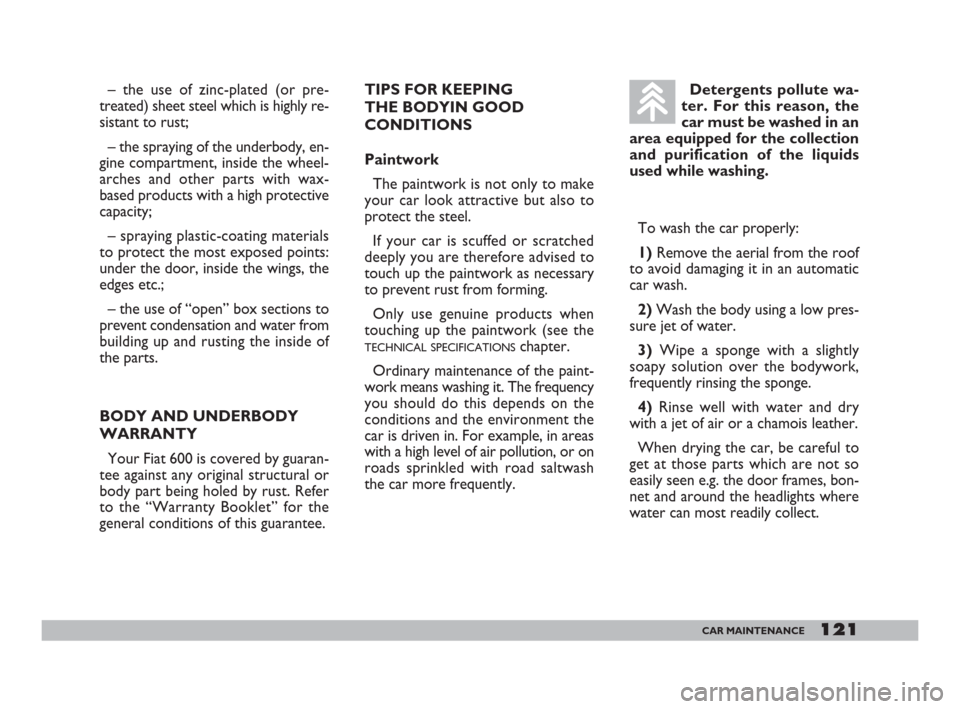
121CAR MAINTENANCE
TIPS FOR KEEPING
THE BODYIN GOOD
CONDITIONS
Paintwork
The paintwork is not only to make
your car look attractive but also to
protect the steel.
If your car is scuffed or scratched
deeply you are therefore advised to
touch up the paintwork as necessary
to prevent rust from forming.
Only use genuine products when
touching up the paintwork (see the
TECHNICAL SPECIFICATIONSchapter.
Ordinary maintenance of the paint-
work means washing it. The frequency
you should do this depends on the
conditions and the environment the
car is driven in. For example, in areas
with a high level of air pollution, or on
roads sprinkled with road saltwash
the car more frequently.Detergents pollute wa-
ter. For this reason, the
car must be washed in an
area equipped for the collection
and purification of the liquids
used while washing.
To wash the car properly:
1) Remove the aerial from the roof
to avoid damaging it in an automatic
car wash.
2) Wash the body using a low pres-
sure jet of water.
3) Wipe a sponge with a slightly
soapy solution over the bodywork,
frequently rinsing the sponge.
4) Rinse well with water and dry
with a jet of air or a chamois leather.
When drying the car, be careful to
get at those parts which are not so
easily seen e.g. the door frames, bon-
net and around the headlights where
water can most readily collect.
– the use of zinc-plated (or pre-
treated) sheet steel which is highly re-
sistant to rust;
– the spraying of the underbody, en-
gine compartment, inside the wheel-
arches and other parts with wax-
based products with a high protective
capacity;
– spraying plastic-coating materials
to protect the most exposed points:
under the door, inside the wings, the
edges etc.;
– the use of “open” box sections to
prevent condensation and water from
building up and rusting the inside of
the parts.
BODY AND UNDERBODY
WARRANTY
Your Fiat 600 is covered by guaran-
tee against any original structural or
body part being holed by rust. Refer
to the “Warranty Booklet” for the
general conditions of this guarantee.
105-123 Seicento GB 22-11-2007 10:51 Pagina 121
Page 123 of 146
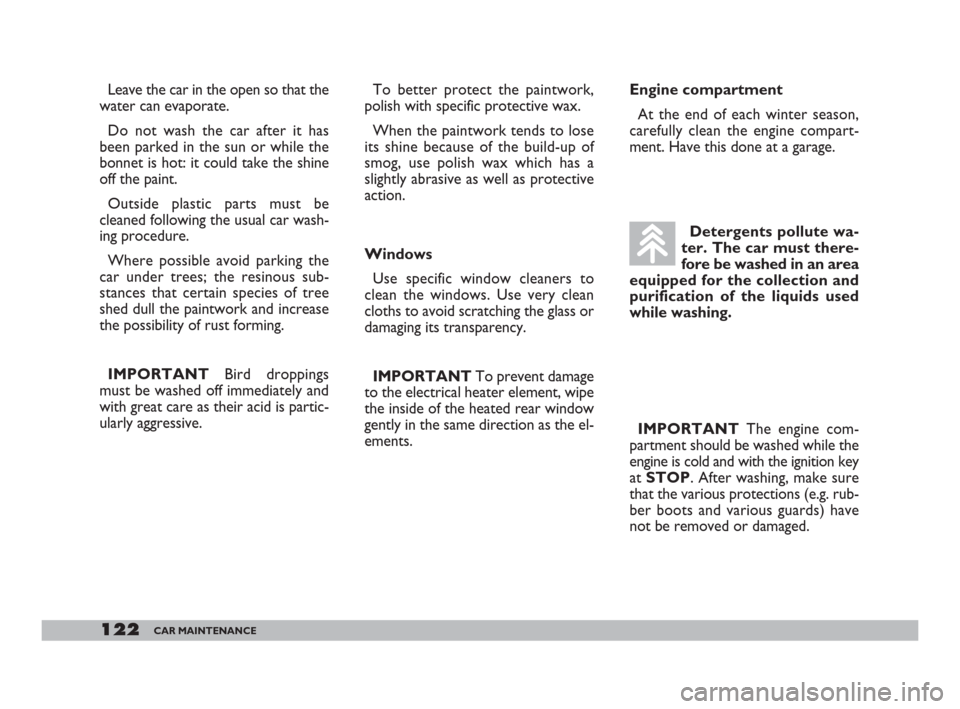
122CAR MAINTENANCE
Engine compartment
At the end of each winter season,
carefully clean the engine compart-
ment. Have this done at a garage. Leave the car in the open so that the
water can evaporate.
Do not wash the car after it has
been parked in the sun or while the
bonnet is hot: it could take the shine
off the paint.
Outside plastic parts must be
cleaned following the usual car wash-
ing procedure.
Where possible avoid parking the
car under trees; the resinous sub-
stances that certain species of tree
shed dull the paintwork and increase
the possibility of rust forming.
IMPORTANT Bird droppings
must be washed off immediately and
with great care as their acid is partic-
ularly aggressive.Detergents pollute wa-
ter. The car must there-
fore be washed in an area
equipped for the collection and
purification of the liquids used
while washing.
IMPORTANTThe engine com-
partment should be washed while the
engine is cold and with the ignition key
at STOP. After washing, make sure
that the various protections (e.g. rub-
ber boots and various guards) have
not be removed or damaged. To better protect the paintwork,
polish with specific protective wax.
When the paintwork tends to lose
its shine because of the build-up of
smog, use polish wax which has a
slightly abrasive as well as protective
action.
Windows
Use specific window cleaners to
clean the windows. Use very clean
cloths to avoid scratching the glass or
damaging its transparency.
IMPORTANT To prevent damage
to the electrical heater element, wipe
the inside of the heated rear window
gently in the same direction as the el-
ements.
105-123 Seicento GB 22-11-2007 10:51 Pagina 122
Page 124 of 146
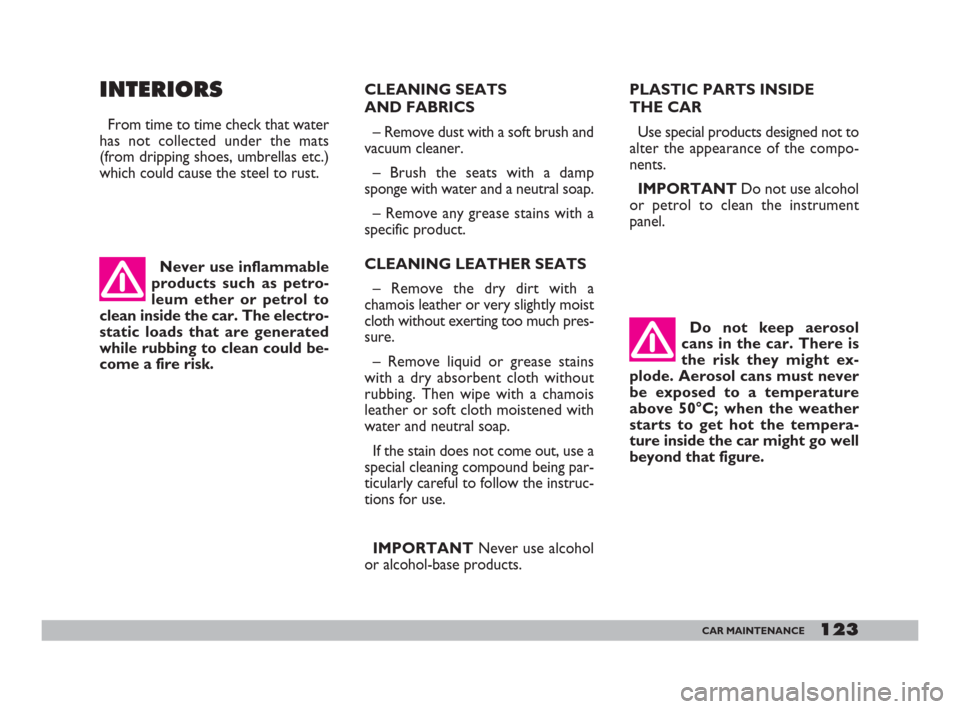
123CAR MAINTENANCE
CLEANING SEATS
AND FABRICS
– Remove dust with a soft brush and
vacuum cleaner.
– Brush the seats with a damp
sponge with water and a neutral soap.
– Remove any grease stains with a
specific product.
CLEANING LEATHER SEATS
– Remove the dry dirt with a
chamois leather or very slightly moist
cloth without exerting too much pres-
sure.
– Remove liquid or grease stains
with a dry absorbent cloth without
rubbing. Then wipe with a chamois
leather or soft cloth moistened with
water and neutral soap.
If the stain does not come out, use a
special cleaning compound being par-
ticularly careful to follow the instruc-
tions for use.
IMPORTANT Never use alcohol
or alcohol-base products.PLASTIC PARTS INSIDE
THE CAR
Use special products designed not to
alter the appearance of the compo-
nents.
IMPORTANT Do not use alcohol
or petrol to clean the instrument
panel.
Do not keep aerosol
cans in the car. There is
the risk they might ex-
plode. Aerosol cans must never
be exposed to a temperature
above 50°C; when the weather
starts to get hot the tempera-
ture inside the car might go well
beyond that figure.INTERIORS
From time to time check that water
has not collected under the mats
(from dripping shoes, umbrellas etc.)
which could cause the steel to rust.
Never use inflammable
products such as petro-
leum ether or petrol to
clean inside the car. The electro-
static loads that are generated
while rubbing to clean could be-
come a fire risk.
105-123 Seicento GB 22-11-2007 10:51 Pagina 123
Page 125 of 146
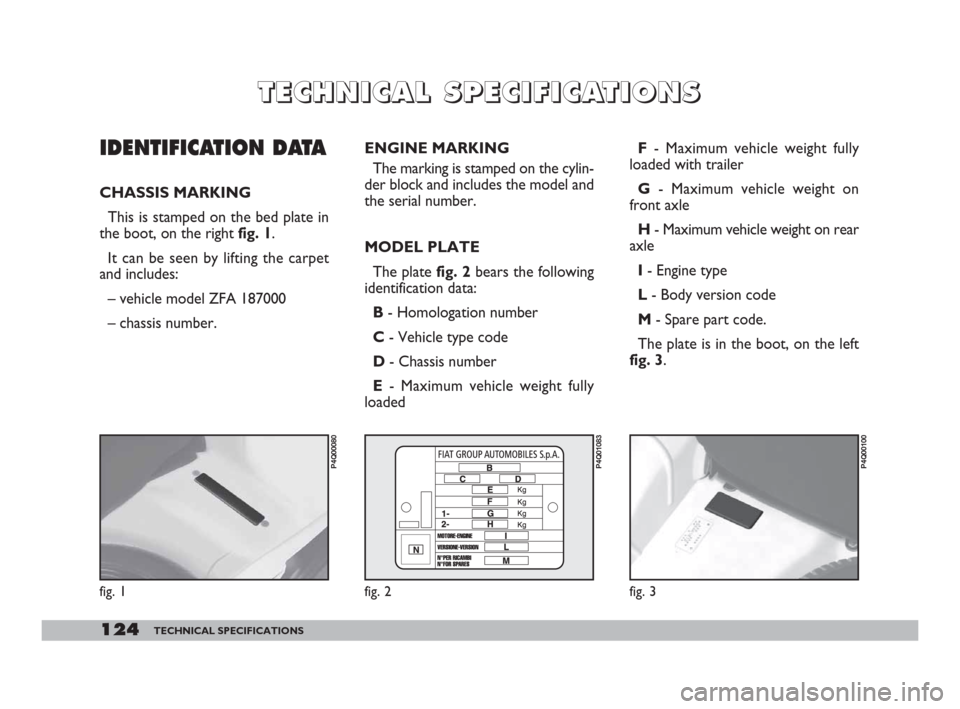
124TECHNICAL SPECIFICATIONS
T T
E E
C C
H H
N N
I I
C C
A A
L L
S S
P P
E E
C C
I I
F F
I I
C C
A A
T T
I I
O O
N N
S S
IDENTIFICATION DATA
CHASSIS MARKING
This is stamped on the bed plate in
the boot, on the right fig. 1.
It can be seen by lifting the carpet
and includes:
– vehicle model ZFA 187000
– chassis number.ENGINE MARKING
The marking is stamped on the cylin-
der block and includes the model and
the serial number.
MODEL PLATE
The plate fig. 2 bears the following
identification data:
B - Homologation number
C - Vehicle type code
D - Chassis number
E - Maximum vehicle weight fully
loadedF - Maximum vehicle weight fully
loaded with trailer
G - Maximum vehicle weight on
front axle
H - Maximum vehicle weight on rear
axle
I - Engine type
L - Body version code
M - Spare part code.
The plate is in the boot, on the left
fig. 3.
fig. 1
P4Q00080
fig. 2
P4Q01083
fig. 3
P4Q00100
124-136 Seicento GB 22-11-2007 10:51 Pagina 124
Page 126 of 146
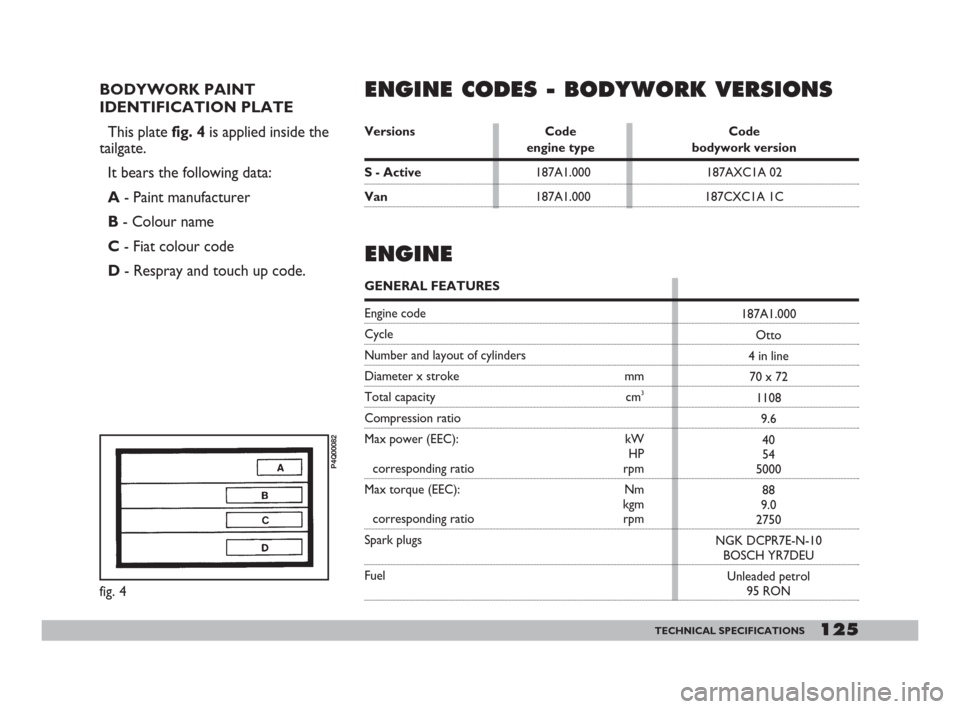
125TECHNICAL SPECIFICATIONS
BODYWORK PAINT
IDENTIFICATION PLATE
This plate fig. 4 is applied inside the
tailgate.
It bears the following data:
A - Paint manufacturer
B - Colour name
C - Fiat colour code
D- Respray and touch up code.
fig. 4
P4Q00082
187AXC1A 02
187CXC1A 1C 187A1.000
187A1.000
Versions Code Code
engine type bodywork version
S - Active
Van
ENGINE CODES - BODYWORK VERSIONS
ENGINE
GENERAL FEATURES
Engine code
Cycle
Number and layout of cylinders
Diameter x stroke mm
Total capacity cm3
Compression ratio
Max power (EEC): kW
HP
corresponding ratio rpm
Max torque (EEC): Nm
kgm
corresponding ratio rpm
Spark plugs
Fuel
187A1.000
Otto
4 in line
70 x 72
1108
9.6
40
54
5000
88
9.0
2750
NGK DCPR7E-N-10
BOSCH YR7DEU
Unleaded petrol
95 RON
124-136 Seicento GB 22-11-2007 10:51 Pagina 125
Page 127 of 146
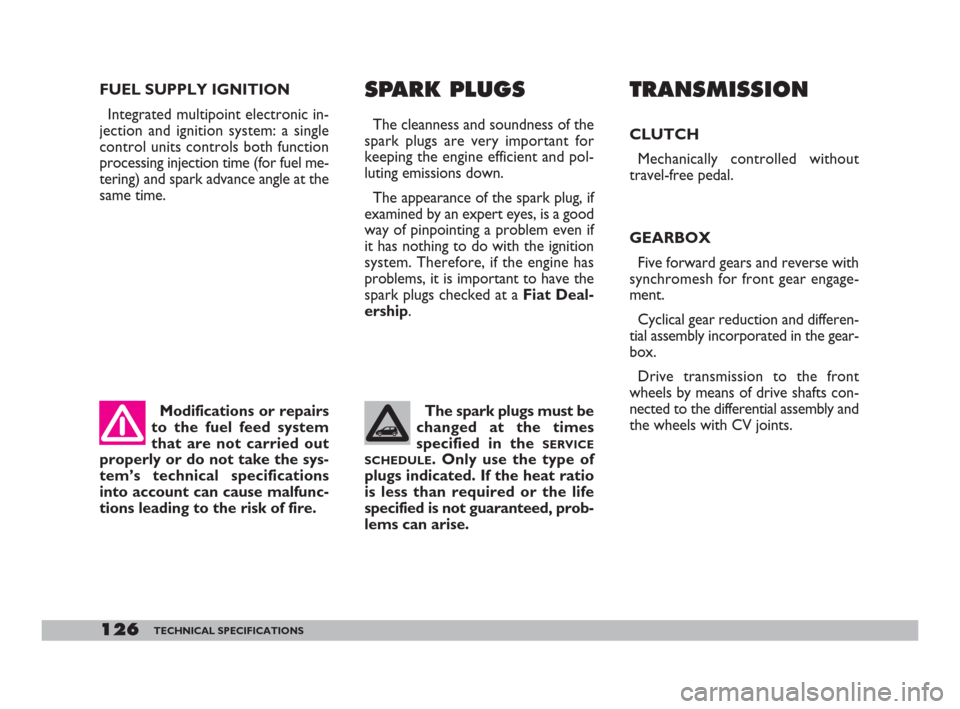
Modifications or repairs
to the fuel feed system
that are not carried out
properly or do not take the sys-
tem’s technical specifications
into account can cause malfunc-
tions leading to the risk of fire. FUEL SUPPLY IGNITION
Integrated multipoint electronic in-
jection and ignition system: a single
control units controls both function
processing injection time (for fuel me-
tering) and spark advance angle at the
same time.
SPARK PLUGS
The cleanness and soundness of the
spark plugs are very important for
keeping the engine efficient and pol-
luting emissions down.
The appearance of the spark plug, if
examined by an expert eyes, is a good
way of pinpointing a problem even if
it has nothing to do with the ignition
system. Therefore, if the engine has
problems, it is important to have the
spark plugs checked at a Fiat Deal-
ership.
TRANSMISSION
CLUTCH
Mechanically controlled without
travel-free pedal.
GEARBOX
Five forward gears and reverse with
synchromesh for front gear engage-
ment.
Cyclical gear reduction and differen-
tial assembly incorporated in the gear-
box.
Drive transmission to the front
wheels by means of drive shafts con-
nected to the differential assembly and
the wheels with CV joints. The spark plugs must be
changed at the times
specified in the
SERVICE
SCHEDULE
. Only use the type of
plugs indicated. If the heat ratio
is less than required or the life
specified is not guaranteed, prob-
lems can arise.
126TECHNICAL SPECIFICATIONS
124-136 Seicento GB 22-11-2007 10:51 Pagina 126
Page 128 of 146
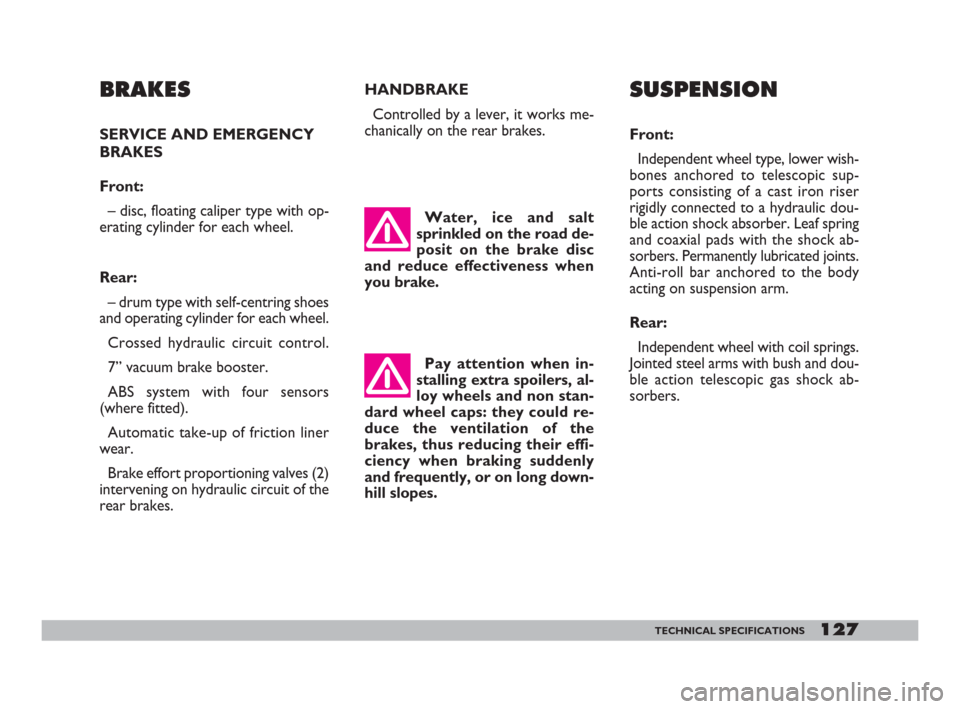
127TECHNICAL SPECIFICATIONS
BRAKES
SERVICE AND EMERGENCY
BRAKES
Front:
– disc, floating caliper type with op-
erating cylinder for each wheel.
Rear:
– drum type with self-centring shoes
and operating cylinder for each wheel.
Crossed hydraulic circuit control.
7” vacuum brake booster.
ABS system with four sensors
(where fitted).
Automatic take-up of friction liner
wear.
Brake effort proportioning valves (2)
intervening on hydraulic circuit of the
rear brakes. HANDBRAKE
Controlled by a lever, it works me-
chanically on the rear brakes.
SUSPENSION
Front:
Independent wheel type, lower wish-
bones anchored to telescopic sup-
ports consisting of a cast iron riser
rigidly connected to a hydraulic dou-
ble action shock absorber. Leaf spring
and coaxial pads with the shock ab-
sorbers. Permanently lubricated joints.
Anti-roll bar anchored to the body
acting on suspension arm.
Rear:
Independent wheel with coil springs.
Jointed steel arms with bush and dou-
ble action telescopic gas shock ab-
sorbers. Water, ice and salt
sprinkled on the road de-
posit on the brake disc
and reduce effectiveness when
you brake.
Pay attention when in-
stalling extra spoilers, al-
loy wheels and non stan-
dard wheel caps: they could re-
duce the ventilation of the
brakes, thus reducing their effi-
ciency when braking suddenly
and frequently, or on long down-
hill slopes.
124-136 Seicento GB 22-11-2007 10:51 Pagina 127
Page 129 of 146
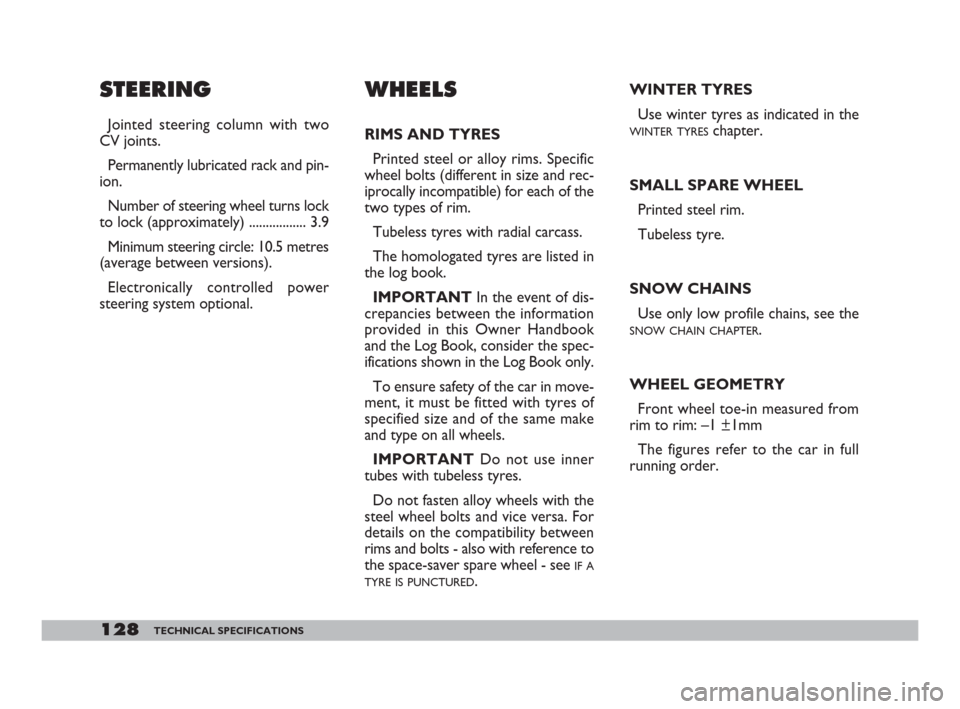
STEERING
Jointed steering column with two
CV joints.
Permanently lubricated rack and pin-
ion.
Number of steering wheel turns lock
to lock (approximately) ................. 3.9
Minimum steering circle: 10.5 metres
(average between versions).
Electronically controlled power
steering system optional.
WHEELS
RIMS AND TYRES
Printed steel or alloy rims. Specific
wheel bolts (different in size and rec-
iprocally incompatible) for each of the
two types of rim.
Tubeless tyres with radial carcass.
The homologated tyres are listed in
the log book.
IMPORTANT In the event of dis-
crepancies between the information
provided in this Owner Handbook
and the Log Book, consider the spec-
ifications shown in the Log Book only.
To ensure safety of the car in move-
ment, it must be fitted with tyres of
specified size and of the same make
and type on all wheels.
IMPORTANT Do not use inner
tubes with tubeless tyres.
Do not fasten alloy wheels with the
steel wheel bolts and vice versa. For
details on the compatibility between
rims and bolts - also with reference to
the space-saver spare wheel - see
IF A
TYRE IS PUNCTURED
. WINTER TYRES
Use winter tyres as indicated in the
WINTER TYRESchapter.
SMALL SPARE WHEEL
Printed steel rim.
Tubeless tyre.
SNOW CHAINS
Use only low profile chains, see the
SNOW CHAIN CHAPTER.
WHEEL GEOMETRY
Front wheel toe-in measured from
rim to rim: –1 ±1mm
The figures refer to the car in full
running order.
128TECHNICAL SPECIFICATIONS
124-136 Seicento GB 22-11-2007 10:51 Pagina 128
Page 130 of 146
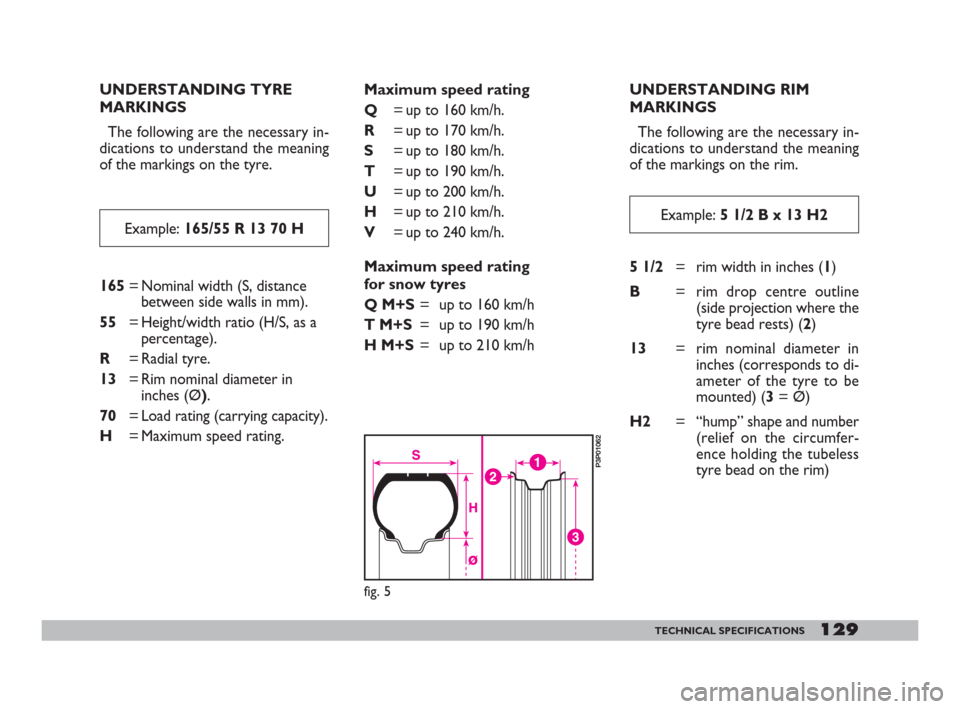
129TECHNICAL SPECIFICATIONS
Example: 5 1/2 B x 13 H2
5 1/2= rim width in inches (1)
B= rim drop centre outline
(side projection where the
tyre bead rests) (2)
13= rim nominal diameter in
inches (corresponds to di-
ameter of the tyre to be
mounted) (3 = Ø)
H2= “hump” shape and number
(relief on the circumfer-
ence holding the tubeless
tyre bead on the rim) UNDERSTANDING RIM
MARKINGS
The following are the necessary in-
dications to understand the meaning
of the markings on the rim. Maximum speed rating
Q= up to 160 km/h.
R= up to 170 km/h.
S= up to 180 km/h.
T= up to 190 km/h.
U= up to 200 km/h.
H= up to 210 km/h.
V= up to 240 km/h.
Maximum speed rating
for snow tyres
Q M+S= up to 160 km/h
T M+S= up to 190 km/h
H M+S= up to 210 km/h Example: 165/55 R 13 70 H
165= Nominal width (S, distance
between side walls in mm).
55= Height/width ratio (H/S, as a
percentage).
R= Radial tyre.
13= Rim nominal diameter in
inches (Ø).
70= Load rating (carrying capacity).
H= Maximum speed rating.
fig. 5
P3P01062
UNDERSTANDING TYRE
MARKINGS
The following are the necessary in-
dications to understand the meaning
of the markings on the tyre.
124-136 Seicento GB 22-11-2007 10:51 Pagina 129